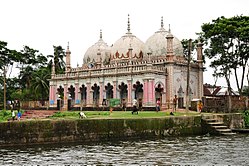Derai Upazila
This article needs additional citations for verification. (July 2015) |
This article possibly contains original research. (October 2021) |
Derai
দিরাই | |
|---|---|
 Mosque in Bhatipara Zamindar Bari | |
 | |
| Country | |
| Division | Sylhet |
| District | Sunamganj |
| Thana | 1942 |
| Upazila | 1982 |
| Government | |
| • MP (Sunamganj-2) | Joya Sengupta |
| • Upazila Chairman | Muhammad Manzur Alam Chowdhury |
| Area | |
| • Total | 420.93 km2 (162.52 sq mi) |
| Population (2011) | |
| • Total | 243,690 |
| • Density | 580/km2 (1,500/sq mi) |
| Time zone | UTC+6 (BST) |
| Postal code | 3040-41 |
| Website | www |
Derai (Bengali: দিরাই) is an upazila (sub-district) of the Sunamganj District in northeastern Bangladesh, part of the Sylhet Division.[1]
History[edit]

Derai was previously known as Babaganj Bazar. It was home to two influential Hindu residents; Jitarāma and Dvidarāma, who renamed the area to Derai Bazar. On 10 December 1892, the Assam Gazette notification #5954 recognised the name of the area as Derai. In 1938, the Nankar Rebellion started in Derai and surrounding areas. Derai was made a thana in 1942.
During the Bangladesh Liberation War of 1971, a brawl took place in Derai between the Pakistan Army and Bengali freedom fighting forces. Among the freedom fighters here, Commander Ataur Rahman and Abdul Khaliq were wounded with Azimullah, Kuti Miah and Gopendra Das being killed.
Derai was heavily affected by the 1974 floods and that of 1988. The Jamiah Hafizia Hussainiya Madrasa was founded in 1978. In 1982, Derai thana was made an upazila. The 2004 Indian Ocean earthquake and tsunami was also very damaging to Derai.[1]
Demographics[edit]
According to the 2011 Bangladesh census, Derai Upazila had 45,040 households and a population of 243,690. 71,432 (29.31%) were under 10 years of age. Derai had a literacy rate (age 7 and over) of 37.13%, compared to the national average of 51.8%, and a sex ratio of 987 females per 1000 males. 36,183 (14.85%) lived in urban areas.[2][3]
As of the 2001 Bangladesh census, Derai has a population of 202791; male 105252, female 97539; Muslim 144136, Hindu 58576, Christian 33 and others 46. Males constitute 51.38% of the population, and females 48.62%.
Education[edit]
In 1991, Derai had an average literacy rate of 25.3% (7+ years), and the national average of 32.4% literate.[4] In 2011, Derai had a literacy rate of 37.13%.
Administration[edit]
Derai thana was formed in 1942 and it was turned into an upazila in 1982.
Derai Upazila is divided into Derai Municipality and nine union parishads: Bhatipara, Charnarchar, Derai Sarmangal, Jagdal, Karimpur, Kulanj, Rafinagar, Rajanagar, and Taral. The union parishads are subdivided into 137 mauzas and 232 villages.[2]
Derai Municipality is subdivided into 9 wards and 29 mahallas.[2]
Upazila Chairmen[edit]
| Number | Name | Notes |
|---|---|---|
| 01 | Nasir Uddin Chowdhury | |
| 02 | Abdul Quddus | |
| 03 | Muhammad Hafizur Rahman Taluqdar | 20/3/2014-9/5/2019 |
| 04 | Muhammad Manzur Alam Chowdhury | Present |
Notable people[edit]
- Gulzar Ahmed Chowdhury, former Member of Parliament
- Suranjit Sengupta, politician, lawyer
- Joya Sengupta, politician
- Kakon Bibi, secret agent
- Mifta Uddin Chowdhury Rumi, politician and justice
- Nasir Uddin Chowdhury, politician
- Nasum Ahmed, cricketer
- Shah Abdul Karim, folk minstrel[5]
See also[edit]
References[edit]
- ^ a b Chanda, Jiban Kumar (2012). "Derai Upazila". In Sirajul Islam; Miah, Sajahan; Khanam, Mahfuza; Ahmed, Sabbir (eds.). Banglapedia: the National Encyclopedia of Bangladesh (Online ed.). Dhaka, Bangladesh: Banglapedia Trust, Asiatic Society of Bangladesh. ISBN 984-32-0576-6. OCLC 52727562. OL 30677644M. Retrieved 27 April 2024.
- ^ a b c d "Bangladesh Population and Housing Census 2011 Zila Report – Sunamganj" (PDF). bbs.gov.bd. Bangladesh Bureau of Statistics.
- ^ "Community Tables: Sunamganj district" (PDF). bbs.gov.bd. Bangladesh Bureau of Statistics. 2011.
- ^ "Population Census Wing, BBS". Archived from the original on 2005-03-27. Retrieved November 10, 2006.
- ^ Mintu, Deshwara (15 February 2016). "Birth centenary of Shah Abdul Karim". The Daily Star.
External links[edit]
 Media related to Derai Upazila at Wikimedia Commons
Media related to Derai Upazila at Wikimedia Commons

